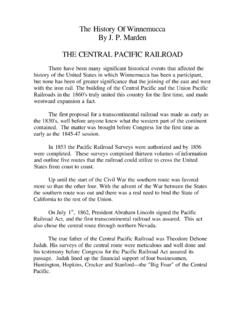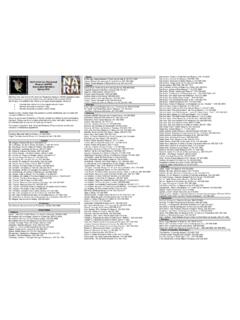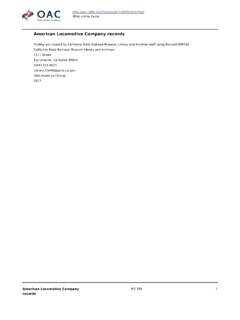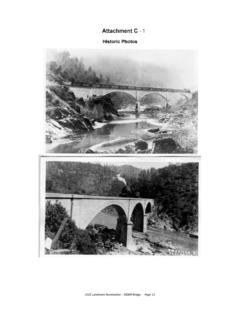Transcription of Nameless Builders of the Transcontinental Railroad
1 Nameless Builders of the Transcontinental Railroad36 CHAPTER FOURC hinese by the NumbersResearch resulting from the payroll records of the Central PacificRailroad Company becomes significant because it changescurrently accepted historical data concerning the initialemployment date and total number of the Chinese employed. Theoriginal records are archived in the basement of the CaliforniaState Railroad Museum in basic issues have, from time to time, raised severalquestions,which I hope to answer with my and who were the first Chinese employed? was the maximum number employed? was this number quantified and qualified?
2 Employment of the First Chinese WorkersFour of the most popular books about the building of theTranscontinental Railroad overlooked documents that pointed tothe exact date of the hiring of the first Chinese Railroad Chapter Seven, The Central Pacific Attacks the Sierra-Nevada, 1865, Stephen E. Ambrose writes in Nothing Like It InThe World:In February, a month after Strobridge s all-but-fruitless callNameless Builders of the Transcontinental Railroad37for labor, Charlie Crocker had met with him and raised thequestion of hiring Chinese. He said some twenty of themhad worked, and worked well, on the Dutch Flat-DonnerLake Wagon Road.
3 2 However, the Central Pacific Payroll Sheets No. 26 and No. 34dated January and February 1864, are the documents that recordthe first Chinese Railroad workers, Hung Wah and Ah Toy,3 whosupervised a crew of 23 unnamed Toy was paid as Railroad foreman at this time, and Hung Wahwas the headman who later became a labor contractor known asthe Hung Wah Company. These men worked for Division 2,Sections 30 and 31. Ah Toy, as headman, collected pay forhimself in the amount of 24 man-days. Hung Wah collected payfor 588 man-days, which equals 23 men working an average of26 days per month, thus adding 24 men who were the firstemployees for the Central Pacific Railroad .
4 This number differsslightly with Ambrose s number of 20, but the difference implies that the Chinese started working on the railroadin 1865, even though the payroll data shows that 23 Chineseworkers were employed in April 1864, Payroll Record 43 again confirms continuedChinese employment because it shows that Hung Wah was paidfor 130 man-days of labor, approximating a crew size of fivemen working on Division 4, Section After the railheadNameless Builders of the Transcontinental Railroad38reached present-day Roseville, lack of funds and materialsstymied progress for the remaining months of was not alone in propagating a later starting date.
5 Otherauthors also believed that the first Chinese workers were hired inthe spring of relates in Chapter 1865 of his book Work of Giants,that as Crocker and Strobridge were on the excavation site of aroadbed east of Newcastle, threatened by the workers who saidthey would quit unless they were paid more, Crocker suggestedthat Strobridge go over to Auburn and hire some Chinese with insufficient white workers, and frustrated by theirunreliable attendance, a reluctant Strobridge gave in to Crocker ssuggestion and hired 50 Chinese. The date and title of thischapter 1865 implies and misleads one to believe that this isthe first hiring of of the Chinese as a viable workforce was beginning toshift in their favor.
6 The first indication of this appears in a letterwritten on April 12, 1865, by Central Pacific s legal counselJudge Crocker to his long time friend Cornelius Cole, whowas retiring as a california writes, "A large part of our force are Chinese, and theyprove nearly equal to white men, in the amount of labor theyperform, and are far more reliable. No danger of strikes amongthem. We are training them to all kinds of labor, blasting, drivinghorses, handling rock, as well as the pick and shovel. 6 Nameless Builders of the Transcontinental Railroad39 Charlie Crocker realized the necessity to employ thousands ofChinese laborers.
7 However, still doubting their value, Strobridge objected because they `were not masons. Crockercountered that the Chinese had to their credit the greatest pieceof masonry in the world -- the Great Wall."7 Crocker prevailed,as Payroll Sheet No. 102 dated March 1865 attests to thebeginning of the mass hiring of Chinese workers, which, becauseof the widespread publicity given to this event, adds support tothe misconception that this marked the first employment of theChinese. This record showed 12 gang bosses collected pay for730 workers. These numbers increased to 1,358 for April and1,218 for May of logical assumption is that the 12-gang bosses, who are listedand named in the March 1865 payroll records, were among thefirst 21 workers for Ah Toy in January 1864, a year and threemonths earlier.
8 As earlier workers of the Central Pacific, theygained enough experience to later become identity of the first 20 Chinese workers relies on the timeperiod and their residence near Auburn. Nearby Dutch Flat wasthe third largest Chinese settlement of that era. An unpublishedresearch paper, "References to Chinese in Dutch Flat," byDouglas Ferrier,8 named Chinese workers who were listed in the1860 and 1870 Federal Census and correlated with payrollrecords of the Central Pacific 12 Chinese names listed as miners in the 1860 Census are:Ah Chung, Ah Wong, Ah Kung, Ah Chin, Ah Fong, Ah Quong, Nameless Builders of the Transcontinental Railroad40Ah Chow, Ah Lim, Ah You, Ah Henge (Hen Gee), Ah Fong, andAh Paw who were also listed in the payroll records.
9 The 1870 Census shows another nine Chinese who gave their occupationsas Railroad worker, and were also on the Central Pacific Railroadpayroll. These men are: Ah You, Ah Chung, Ah Wah, Ah Ming,Gee Tong, Ah Jim, Ah Hing, Ah Tou (Too),and Ah the census been taken before 1870, perhaps a higher numberof Chinese would have correlated with a larger percentage ofnames in the payroll records because after the completion of theTranscontinental, most of the Chinese were laid off and movedout of the Many Chinese Worked for the Central Pacific?It was the Railroad s policy that a headman or labor contractorcollected pay (in coins) for all the workers in his crew.
10 GeorgeKraus states in his article Chinese Laborers and theConstruction of the Central Pacific, that a method was used bythe Railroad company to count the total number of workers at thebeginning of the morning shift, at lunch, and at the end of theshift to compare the total hours of wages turned in by the gangboss to prevent overpayment. It was said that one could not tellthe difference between the Chinese and the Indian of this policy it is improbable that the individual namesof the actual laborers will ever be is commonly reported that peak employment of Chineseworkers by the Central Pacific ranges from 10,000 to 20,000.










